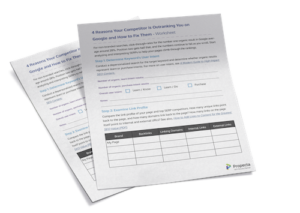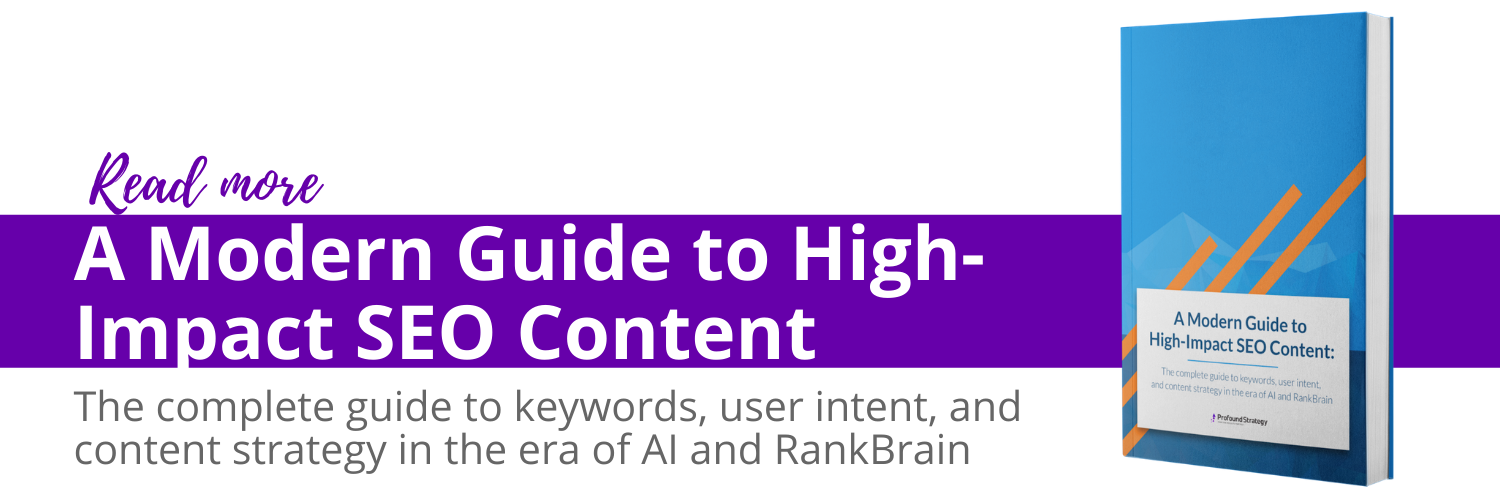4 Reasons Your Competitor is Outranking You on Google (and How to Fix Them)
For non-branded searches, click-through-rates for the number one organic result in Google average around 28%. For position two, CTRs are halved, receiving an average of only 14% of clicks, and the numbers continue to fall as you scroll. If competitors are outranking you—even by only one position—they’re claiming more clicks, generating more leads, and earning more revenue.
Instead of settling for “at least we’re on page one,” take action to secure the higher position. Conduct a competitive analysis to determine what competitors are doing right. Then, use the results of the analysis to create a plan for outranking your competition in Google.
When you’re ready to get started, scroll to the bottom of this post and download our free SERP Analysis Worksheet!
Why Is My Competitor Ranking Higher?
Google considers 200+ ranking factors for every query, so it’s easy to imagine that there could be hundreds of potential reasons why competitors are earning higher rankings. But it’s usually not so complicated. A higher ranking usually means a piece of content does a better job of answering user intent and satisfying RankBrain’s priority ranking factors.

RankBrain is Google’s machine learning program that evaluates and re-evaluates individual ranking factors for different industries and queries.
Because Google knows that even their sophisticated list of ranking factors isn’t one-size-fits-all. In some industries, links are hugely important, for example, but less so in others. For some topics, timeliness is crucial, but others don’t need updated for years. RankBrain’s job is to figure out what is important and adjust ranking factor priorities accordingly.
Use Google’s SERPs to conduct a competitive analysis, and compare the user intent and RankBrain factors of your content to those of other page-one results.
1. The Content Better Answers User Intent for Target Keywords
The number one reason content fails to earn high rankings is because it doesn’t satisfy user intent—the real question or need behind the keyword being typed into a search engine. Google prioritizes organic results that provide the best answers.

To uncover user intent, conduct a depersonalized search for the problematic keyword, and review all page-one organic results. This exercise provides insight into whether user intent is learn or purchase:
- Learn intent means the user is trying to expand his/her knowledge or complete a task. Introductory-level content, how-to guides, and definition featured snippets are all good indicators of learn intent.
- Purchase intent suggests that the user has decided to make a purchase and is comparing options. User reviews, product comparison lists, and competitor product pages suggest that user intent for that keyword is purchase.
With user intent identified, revisit your content and determine if it satisfies intent for the targeted keyword. If the keyword has learn intent and content is a purchase-intent product page, it will never rank well in organic search. Update the content of the page to cater to learn intent—provide more high-level, introductory, and in-depth content. The content should cater to users at the top—rather than the bottom—of the funnel.
2. The Content has a Better Link Profile
Quantity and quality of incoming and outgoing links is another potential ranking factor. It may be higher priority in some industries than others, per RankBrain, but Google has identified links as a top factor so it’s wise to assume it’s a priority. The next step, then, is analyzing link profiles for higher-ranking competitors’ results.

Using the MozBar Chrome extension or another link metrics tool, record the number of incoming links and linking domains (RD = root domains) for higher-ranking competitor results.
Links within the content are also important. Click into the top few content pieces and use the Link Analysis tab in the Moz Bar to highlight internal and external links in the content, to make them easier to count.
Record findings in a table. Complete steps 1-4 for your content and all higher-ranked competitor results.
Compare the results:
- If higher-ranking results have many more incoming links or linking domains, promote content to earn more incoming links.
- If higher-ranking results have more on-page links, revisit the content to see where more links can be added to the content.
- If competitor link analysis fails to deliver any valuable insights or takeaways, link profiles may not be an important ranking factor for that query.
3. The Content is … Better
Google’s number one ranking factor is content quality. If a competitor result is ranking higher, it’s entirely possible that the content is simply better—higher quality—in Google’s opinion.

Improving content quality can be tricky. There are roughly 77 potential factors factors Google considers when evaluating quality. The best thing to do is dive in, review content like an editor or outside observer, and consider how its quality compares to competitor content.
Some of the more important quality indicators include:
- Formatting – Is the content easy to read? Restrict paragraphs to no more than five lines of text, use H2 and H3 tags to break content apart into easily digestible sections, and intersperse original and relevant images throughout content.
- Comprehensiveness – Does it answer all of the questions users might have about a topic? Expand content to include related topics and answer common questions, or provide in-text links to relevant content.
- Accuracy – Is the content clear, accurate, and without spelling or grammatical errors? Errors and inaccuracies can minimize authority and diminish trust instantly. Hire an editor, or at least ask a co-worker to proofread and fact-check the final product.
- Targeting – Is content addressed to the right audience? If your content is written for executives, but higher-ranking results are written for individual contributors, content may need to be revised to cater to the people who are interested in reading it.
Also, consider how content appears in search results. Review the title, meta description, and other elements of how content appears in the SERPs. Compare your result with others, and record ideas on how to make the listing stand out to inspire more clicks.
4. The Content Has What RankBrain is Looking For
In addition to content quality and link profiles, RankBrain looks at many other factors to determine how content should be ranked.

To identify additional factors, return to the depersonalized search conducted while analyzing user intent, and open all page-one organic results in new tabs.
- Look at the publication or last-updated date. Content freshness can be a ranking factor for some queries. If most page-one results were published within the last year, six months, or month—but your content is much older—it may be time to revise, update, and republish the content. Similarly, if titles and/or meta descriptions include the current year (“for 2017,” etc.), timeliness is probably important.
- Look at the type of media used. Do top results make better use of media—videos, images, or infographics? Consider embedding a video into content or creating an infographic to go along with text-based content.
- Look at the depth of coverage. Find ideas for how to make content more comprehensive by identifying important topics covered on other page-one results. Also evaluate the length of content in top results—if most results are 3,000+ words, length may be a ranking factor. Expand or delete text as needed.
- Consider additional topics and keywords. Review the “People also ask” questions and “Searches related to” keyword suggestions from the SERPs. This provides more detail on additional types of information users are seeking when searching for targeted keywords. Provide coverage of related topics in content.
- Collect data on load speeds. Run your site and outranking competitor sites through Google’s PageSpeed Insights tool. If competitor sites load faster, work with a developer to optimize site performance.
This exercise allows you to develop a personalized ranking factors list by identifying consistencies in high-ranking content for targeted keywords.
How to Outrank Your Competition in Google
 Study the SERPs, analyze link profiles, and evaluate the content of higher-ranking results to develop a detailed strategy for increasing user engagement and catering to the factors Google has prioritized.
Study the SERPs, analyze link profiles, and evaluate the content of higher-ranking results to develop a detailed strategy for increasing user engagement and catering to the factors Google has prioritized.
Then, optimize content using the insights gathered to outrank competitor results; start earning increased traffic, leads, and revenue; and stop losing customers to competitors.
Start by conducting user intent research. If content caters to the wrong intent, it will never rank higher than competitor content that answers the question behind the query. Update content to cater to the correct intent, and see your result starts to climb.
What's Next?
Profound Strategy is on a mission to help growth-minded marketers turn SEO back into a source of predictable, reliable, scalable business results.
Start winning in organic search and turn SEO into your most efficient marketing channel. Subscribe to updates and join the 6,000+ marketing executives and founders that are changing the way they do SEO:
And dig deeper with some of our best content, such as The CMO’s Guide to Modern SEO, Technical SEO: A Decision Maker’s Guide, and A Modern Framework for SEO Work that Matters.





![An Intro to Google Posts for B2B Marketers [Update: PDF Guide Now Available]](https://profoundstrategy.com/wp-content/uploads/cheap-seo-1030x350.jpg)